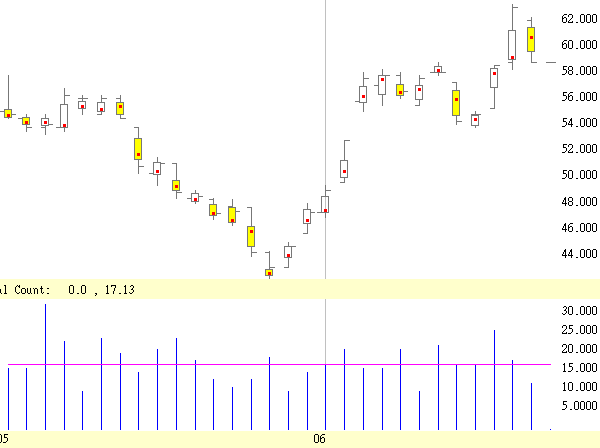|
Prosticks Articles
經濟日報6月20日
聚焦點與時間的關係
成交量的重要性,人所周知。但在某些情況下,成交量卻會誤導人。例如,某股票停牌已久,
卻在下午市復牌,或一些特別交易、轉倉等。乾坤燭中的一項技術指標--聚焦量,可以彌補以
上缺陷。
讓我們從投資者心理的角度,來分析成交時間的重要性。
當投資者看住報價機,發現某一個價位(如$5.8)在一天之中多次
出現,不論清醒地還是下意識之間,他們會同意$5.8這個價位很重要,並不理會在$5.8
的實際成交量。大多數投資者,即使認同成交量的重要性。但只要他們盯住報價機,發現
$5.8頻繁出現,他們仍然傾向於放更多的注意力在$5.8上。
當市場花太多時間在一個價位上買賣,意味著一些事即將發生,單
邊市況或會來臨。假如市場花太多時間去嘗試衝擊一個阻力位或支持位,卻以失敗告終,
大多數人就會認同這個阻力位或支持位的程度堅固。
因此,市場花在不同價位上的時間總和,能用以洞察市場反應,找
出轉捩點。
時間和成交量亦是密切相關的,在成交活躍的市場,如外匯、期指
、籃籌等,造價時間愈長的價位,很自然地,其成交量也愈大。
如此一來,有兩種方法來判定聚焦點,即是成交時間法和成交量法
。在成交量法中,聚焦點是成交最大的價位,而在成交時間方法中,聚焦點是市場花費最
多時間的價位。在正常情況下,從這兩種方法計算出來的聚焦點很接近。不過以我們的研
究,預測支持位或阻力位,用時間法較好。
如何測定市場花費在一個價位的時間總和?方法是,劃分交易時段
為一個最小的單位,如5分鐘,然後找出在該價位的交易有多少個5分鐘。例如,假定$5.8
的交易發生在10:00-10:05,11:15-11:20,14:50-14:55,則市場在$5.8的交易時間總和
是3個單位。最大單位數量的價位即是聚焦點(如$5.8),聚焦點的交易時間總和即是聚
焦量(如3)。
附圖為新鴻基地產(0016)的乾坤燭圖及其聚焦量,其應用方法,
明天詳談。

| 

